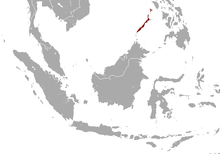Philippine pangolin
| Philippine pangolin | |
|---|---|
 | |
| Philippine pangolin on a 2015 stamp of the Philippines | |
| Scientific classification | |
| Kingdom: | Animalia |
| Phylum: | Chordata |
| Class: | Mammalia |
| Order: | Pholidota |
| Family: | Manidae |
| Genus: | Manis |
| Species: | M. culionensis |
| Binomial name | |
| Manis culionensis de Elera, 1895 | |
 | |
| Philippine pangolin range | |
The Philippine pangolin or Palawan pangolin, also known as the balintong (Manis culionensis), is a pangolin species endemic to the Palawan province of the Philippines. Its habitat includes primary and secondary forests, as well as surrounding grasslands. This species is moderately common within its limited range, but is at risk due to heavy hunting because of its valued scales and meat.[2] This species is distinguished from the closely related Sunda pangolin by its smaller body-to-tail ratio, smaller scales, and a shorter head.[3]
Taxonomy
The species was first described by Casto de Elera in 1885; it was also mentioned by de Elera in an 1895 work.[4][5] In the past, this species has been included with the Sunda pangolin, Manis javanica, but has been considered a distinct species since 1998.[6] Five distinct morphological characteristics involving the skull and the scales have been identified which separate it from the closely related M. javanica. Both M. javanica and M. culionensis are grouped in subgenus Paramanis.[7] Genetic isolation leading to the speciation between these species is hypothesized to have been caused by rising sea levels severing a land bridge from Borneo in the Early Pleistocene.[8]
Diet
The Philippine pangolin is a myrmecophage, so has a diet consisting mainly of ants and termites. It uses its long tongue with a coating of adhesive saliva to harvest insects. Pangolins have no teeth and consume sand and small stones to help grind food in their stomachs.[9]
Behavior
The Philippine pangolin is nocturnal and reclusive and tends to be solitary. While some of their time is spent on the ground foraging, Philippine pangolins tend to stay in trees. When threatened, they, like all pangolins, roll into a ball and rely on the protection provided by their scales.
Reproduction
While little is known about the reproduction of Philippine pangolins, their mating habits are thought to be similar to those of the Sunda pangolin. Like most pangolins, Philippine pangolins mate in the spring. The young are born after a gestation period around 18 weeks and are suckled by their mothers about four months.[10]
References
| Wikimedia Commons has media related to Manis culionensis. |
| Wikispecies has information related to: Manis culionensis |
- ↑ Lagrada, L.; Schoppe, S. & Challender, D. (2014). "Manis culionensis". IUCN Red List of Threatened Species. Version 2014.2. International Union for Conservation of Nature. Retrieved 2014-07-29.
- ↑ Manis culionensis in A synopsis of the mammilian fauna of the Philippine Islands. The Field Museum.
- ↑ "Philippine Pangolin". Pangolinsg.org. Retrieved on 2016-06-22.
- ↑ Schlitter, D.A. (2005). "Order Pholidota". In Wilson, D.E.; Reeder, D.M. Mammal Species of the World: A Taxonomic and Geographic Reference (3rd ed.). Johns Hopkins University Press. p. 530. ISBN 978-0-8018-8221-0. OCLC 62265494.
- ↑ Catálogo sistemático de toda la fauna de Filipinas: conocida hasta el presente, y á la vez el de la colección zoológica del Museo de PP. Dominicos del Colegio-universidad de Sto. Tomás de Manila, escrito con motivo de la Exposición Regional Filipina Imprenta del Colegio de Santo Tomás, 1895
- ↑ ITIS Standard Report for ''Manis culionensis'' Taxonomic Serial No.: 727709. Itis.gov. Retrieved on 2016-06-22.
- ↑ Paramanis in Wilson and Reeder's Mammal Species of the world: 3rd Edition
- ↑ Gaubert, Philippe; Antunes, Agostinho (2005). "Assessing the Taxonomic Status of the Palawan Pangolin Manis Culionensis (Pholidota) Using Discrete Morphological Characters". Journal of Mammalogy. 86 (6): 1068. doi:10.1644/1545-1542(2005)86[1068:ATTSOT]2.0.CO;2.
- ↑ Philippine Pangolin. The Animal Files. Retrieved on 2016-06-22.
- ↑ Helmsworth, A. (2011). Manis culionensis. Animal Diversity Web.
